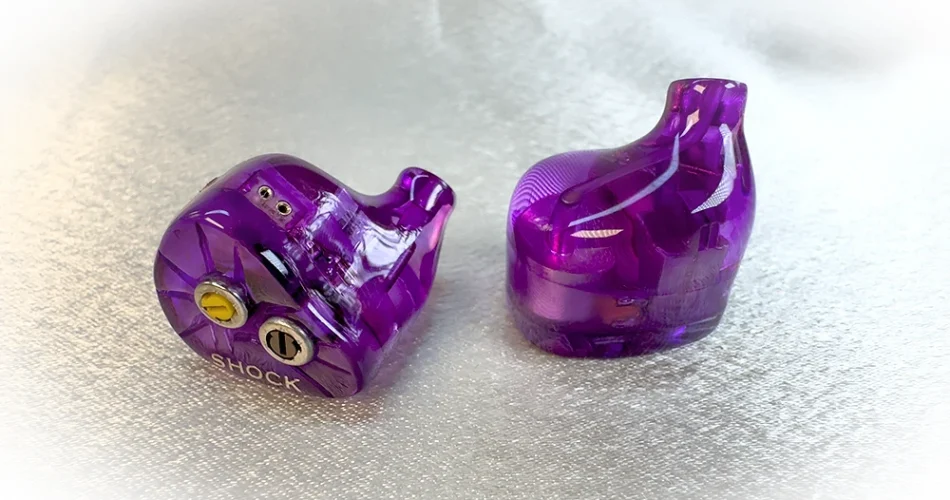Sound Impressions

I used a Luxury & Precision P6 Pro HK set to hi-gain mode at 9/60 volume to evaluate the SHOCKs, as I listen at lower volumes. This is the Tidal playlist of tracks I use to evaluate IEMs.
The SHOCKs utilise 2x 8mm DDs for bass, 2x Knowles BAs for midrange, 2x Sonion BAs for treble along with 2 full-range BCDs. They’re somewhat L-shaped with powerful bass, a slightly recessed midrange & fairly dark treble, yet bass & treble are fully tuneable with physical dials.
Bass
Bass is significantly north of neutral, with double DDs delivering satisfying slam and rumble.
Midbass in particular is strongly emphasised which contributes to exceptional note weight at lower frequencies, sub bass is a little more toned down but still punchy with no feeling of hollowness.
Overall bass is very meaty and satisfying, though midbass can become a tad overwhelming on certain tracks. Bass texture is not the very best I’ve heard from IEMs at this price & could use a tad more bite.

Midrange
Vocals are positioned further away the listener, and can feel somewhat small & recessed as a result. The upper midrange is emphasised to prioritise clarity over smoothness & naturalness.
The midrange can come across as grainy and a tad congested at times, and I would prefer more lower midrange warmth. The tuning reminds me of one closer to the Harman Target than other TSMR IEMs.
It feels like the midrange ingredients are there for a satisfying meal, but a dash of spice to make the recipe work is absent. There’s a pronounced sense of spaciousness to midrange instruments however, which may encourage you to overlook other shortcomings.
Treble
Treble is slightly unrefined & fairly dark on the stock tuning setting, upper treble in particular is subdued. This can be rectified by adjusting the treble knob to a substantial extent however.
Overall treble quality is perhaps on the grainer side, and this is where implementing EST drivers may have delivered smoother and more detailed treble.
It feels like BCDs were substituted for ESTs as it would’ve been very difficult for TSMR to include both at this pricepoint, and I don’t particularly mind the tradeoff as those BCDs definitely give the SHOCKs an enhanced sense of scale, but the lack of treble refinement effectively becomes the price of that.
Technical Performance

Staging depth is particularly impressive and this is where BCD drivers provide a unique experience almost unobtainable without them. There’s a sense of spaciousness between each instrument which makes the soundstage feel almost endless even though the dimensions are fixed. It really does feel as though sounds are coming from in front of your head rather than off to the sides, with a satisfying impression of dimensionality non-BCD IEMs usually lack.
Imaging suffers from BCD haze and may be worth the tradeoff due to the unique staging qualities, but a sense of pinpoint precision is absent. Lowering bass via the tuning knob can slightly sharpen imaging as the stock bass quantity can otherwise cloud the stage.
Resolution is slightly below par for this price range and instruments can instruments sound a tad congested at times. The drivers don’t seem to have any trouble keeping up with fast music, but the midbass-heavy tuning can muddy things occasionally. There’s a little bit of grain in the midrange & treble.
Note weight in the lower frequencies is particularly good due to the midbass-emphasised tuning, those two DDs really do a superb job there.
Dynamic range is adequate without being a standout attribute, and it feels like here too those BCDs & their shimmering haze are clouding the SHOCKs’ ability to highlight instruments more distinctly.
Tuning Knobs

Historically I’ve never been a fan of tuning switches, which always feel like a great idea in theory but in implementation rarely line up with my exact preferences – that’s where tuning dials may have the advantage, offering greater potential flexibility.
TSMR ships the SHOCKs with a small screwdriver that’s perfect for adjusting the two bass & treble dials, the only difficulty is matching both IEMs perfectly. There are small notches on the sides of each dial like markers on an analogue clock which make this easier.
Sadly the bass dial’s default position feels like it’s 60 or 70% of the way towards the max setting, so you’ll get more bass turning the dial but there isn’t as much extra available as I expected. Admittedly the SHOCKs are already bass-heavy by default, but some bassheads may wish for more.
The treble dial works better because SHOCKs are quite dark as stock, and the treble dial’s default setting feels only 30% of maximum so there’s plenty more treble to be gained if you desire.
The restriction of both dials is only one specific bass & treble frequency gets raised, which may not be the exact one you want. Still, it’s a capable system and not one we see implemented in IEMs often.
Page 1 – Introduction, Packaging & Ergonomics
Page 2 – Sound Impressions, Technical Performance & Tuning Knobs
Page 3 – IEM Comparisons
Page 4 – Cable Comparisons
Page 5 – Conclusion


Comments